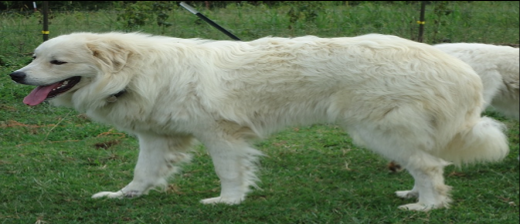Flashlight Farmers
Genetic Diseases in Great Pyrenees
We currently complete health testing on all our AKC dams and sires. We submit x-rays to OFA for grading of hips and patellae. OFA receives applications signed by our vet for elbow dysplasia and basic cardiac exam. Genetic screening is performed to rule out Degenerative Myelopathy and Canine Multifocal Retinopathy. BAER hearing test results are submitted to OFA by evaluation by audiologists.
Current OFA Statistics
Hip Dysplasia: Abnormal 9.4%
Elbow Dysplasia: Abnormal 1.8%
Patellar Luxation: Abnormal 1.0%
Cardiac Disease: Abnormal 0.3%
Degenerative Myelopathy: Abnormal 5.9%, Carrier 14%
Canine Multifocal Retinopathy: Abnormal 8.3%, Carrier 29.4%
Congenital Deafness: Abnormal 6.1%
Glanzmann Thrombasthenia: Abnormal 0.0%, only 50 dogs tested
Von Willebrand's Disease: ------ less than 50 dogs tested
1. Hip Dysplasia begins to affect dogs as they age. If your dog has the disease, its hip joints will loosen and become unstable. This condition can be exacerbated by age and weight gain. Affected dogs will lose cartilage over time and begin to develop bone spurs in their hip joints. Canine hip dysplasia occurs most frequently in large breed dogs.
2. Elbow Dysplasia is the disease most commonly implicated in front limb lameness (limping) in dogs. It occurs when the bones that make up the elbow joint don't come together just right, leading eventually to painful movement in the forelimb.
3. Patellar Luxation. The term luxating means 'out of place' or 'dislocated'. Therefore, a luxating patella is a kneecap that moves out of its normal location. Pet owners may notice a skip in their dog's step or see their dog run on three legs. Then suddenly they will be back on all four legs as if nothing happened. Patellar luxation predisposes the knee to other injuries, such as torn cruciate ligaments. The weight bearing stress on the leg is also altered, leading to changes in the hips, thigh, and shin bones. As the pet ages, arthritis develops and results in not only decreased mobility but joint pain as well.
5. Cardiac Disease Congenital heart disease in dogs is a malformation of the heart or great vessels. Often these heart defects are transmitted genetically.
6. Degenerative Myelopathy is a disease affecting the spinal cord, resulting in slowly progressive hind limb weakness and paralysis. The symptoms result from degeneration of the white matter of the spinal cord. DM is similar to some of the forms of human amyotrophic lateral sclerosis (ALS) more commonly known as Lou Gehrig's Disease. The condition is most common in middle-aged to older dogs, with a range from 4-14 years. It has been reported in young dogs on rare occasions.
6. Glanzmann Thrombasthenia is a rare inherited blood clotting (coagulation) disorder characterized by the impaired function of specialized cells (platelets) that are essential for proper blood clotting. Symptoms of this disorder usually include abnormal bleeding, which may be severe.
7. Von Willebrand's Disease is a blood disorder in which the blood does not clot properly. Blood contains many proteins that help the blood clot when needed. One of these proteins is called von Willebrand factor (VWF).
8. Canine Multifocal Retinopathy is an autosomal recessive eye disorder known to affect Great Pyrenees. The mutation causes raised lesions to form on the retina. The lesions alter the appearance of the eye but usually do not affect sight. The lesions may disappear, or may result in minor retinal folding. Symptoms of the mutation usually appear when a puppy is only a few months old, and generally do not worsen over time.
9. Congenital Deafness Since 95% of dogs with inherited deafness are unilateral, affecting only one ear with varying degrees of hearing loss, most dogs carrying two deaf genes appear to hear normally and are never diagnosed. The only reliable test for a dog with two deafness genes is the the brainstem auditory evoked response (BAER) which detects electrical activity in the cochlea and auditory pathways in the brain in much the same way that an antenna detects radio or TV signals or an EKG detects electrical activity of the heart. There is no genetic test to detect abnormal or carrier dogs, and since carriers can hear normally, they are only identified when mated to another carrier and produce a deaf puppy.
We currently complete health testing on all our AKC dams and sires. We submit x-rays to OFA for grading of hips and patellae. OFA receives applications signed by our vet for elbow dysplasia and basic cardiac exam. Genetic screening is performed to rule out Degenerative Myelopathy and Canine Multifocal Retinopathy. BAER hearing test results are submitted to OFA by evaluation by audiologists.
Current OFA Statistics
Hip Dysplasia: Abnormal 9.4%
Elbow Dysplasia: Abnormal 1.8%
Patellar Luxation: Abnormal 1.0%
Cardiac Disease: Abnormal 0.3%
Degenerative Myelopathy: Abnormal 5.9%, Carrier 14%
Canine Multifocal Retinopathy: Abnormal 8.3%, Carrier 29.4%
Congenital Deafness: Abnormal 6.1%
Glanzmann Thrombasthenia: Abnormal 0.0%, only 50 dogs tested
Von Willebrand's Disease: ------ less than 50 dogs tested
1. Hip Dysplasia begins to affect dogs as they age. If your dog has the disease, its hip joints will loosen and become unstable. This condition can be exacerbated by age and weight gain. Affected dogs will lose cartilage over time and begin to develop bone spurs in their hip joints. Canine hip dysplasia occurs most frequently in large breed dogs.
2. Elbow Dysplasia is the disease most commonly implicated in front limb lameness (limping) in dogs. It occurs when the bones that make up the elbow joint don't come together just right, leading eventually to painful movement in the forelimb.
3. Patellar Luxation. The term luxating means 'out of place' or 'dislocated'. Therefore, a luxating patella is a kneecap that moves out of its normal location. Pet owners may notice a skip in their dog's step or see their dog run on three legs. Then suddenly they will be back on all four legs as if nothing happened. Patellar luxation predisposes the knee to other injuries, such as torn cruciate ligaments. The weight bearing stress on the leg is also altered, leading to changes in the hips, thigh, and shin bones. As the pet ages, arthritis develops and results in not only decreased mobility but joint pain as well.
5. Cardiac Disease Congenital heart disease in dogs is a malformation of the heart or great vessels. Often these heart defects are transmitted genetically.
6. Degenerative Myelopathy is a disease affecting the spinal cord, resulting in slowly progressive hind limb weakness and paralysis. The symptoms result from degeneration of the white matter of the spinal cord. DM is similar to some of the forms of human amyotrophic lateral sclerosis (ALS) more commonly known as Lou Gehrig's Disease. The condition is most common in middle-aged to older dogs, with a range from 4-14 years. It has been reported in young dogs on rare occasions.
6. Glanzmann Thrombasthenia is a rare inherited blood clotting (coagulation) disorder characterized by the impaired function of specialized cells (platelets) that are essential for proper blood clotting. Symptoms of this disorder usually include abnormal bleeding, which may be severe.
7. Von Willebrand's Disease is a blood disorder in which the blood does not clot properly. Blood contains many proteins that help the blood clot when needed. One of these proteins is called von Willebrand factor (VWF).
8. Canine Multifocal Retinopathy is an autosomal recessive eye disorder known to affect Great Pyrenees. The mutation causes raised lesions to form on the retina. The lesions alter the appearance of the eye but usually do not affect sight. The lesions may disappear, or may result in minor retinal folding. Symptoms of the mutation usually appear when a puppy is only a few months old, and generally do not worsen over time.
9. Congenital Deafness Since 95% of dogs with inherited deafness are unilateral, affecting only one ear with varying degrees of hearing loss, most dogs carrying two deaf genes appear to hear normally and are never diagnosed. The only reliable test for a dog with two deafness genes is the the brainstem auditory evoked response (BAER) which detects electrical activity in the cochlea and auditory pathways in the brain in much the same way that an antenna detects radio or TV signals or an EKG detects electrical activity of the heart. There is no genetic test to detect abnormal or carrier dogs, and since carriers can hear normally, they are only identified when mated to another carrier and produce a deaf puppy.
Pyr Harbor Special Ops Gunner

CKC Sailor
AKC Dams
Shelby
Honey
Baby
Aspen
Tonka
Fancy
Pebbles
Ariel
LuLu
Bailey

























